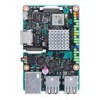Asus Tinker Board E15215TinkerBoardSeriesEMWEB
Asus Tinker Board Manual
 |
View all Asus Tinker Board manuals
Add to My Manuals
Save this manual to your list of manuals |
Asus Tinker Board manual content summary:
- Asus Tinker Board | E15215TinkerBoardSeriesEMWEB - Page 1
Tinker Board Series User Manual - Asus Tinker Board | E15215TinkerBoardSeriesEMWEB - Page 2
service will not be extended if: (1) the product is repaired, modified or altered, unless such repair, modification of alteration is authorized in writing by ASUS; or (2) the serial number of the product is defaced or missing. ASUS PROVIDES THIS MANUAL https://www.asus.com/support/ or (2) problems - Asus Tinker Board | E15215TinkerBoardSeriesEMWEB - Page 3
up using eMMC (Tinker Board S only 5 2.2 Setting up using a microSD card 6 3. Writing the OS image 7 3.1 Using Etcher (Cross-platform 7 3.2 Using dd command (Linux 9 4. OS Write Recovery (Tinker Board S only 10 4.1 Rewriting the OS using UMS from eMMC 10 4.2 Rewriting the OS using UMS from - Asus Tinker Board | E15215TinkerBoardSeriesEMWEB - Page 4
of the following symbols used throughout this manual. DANGER/WARNING: Information to prevent injury to yourself when trying to complete a task. CAUTION: Information to prevent damage to the components when trying to complete a task. IMPORTANT: Instructions that you MUST follow to complete a task - Asus Tinker Board | E15215TinkerBoardSeriesEMWEB - Page 5
system image such as the Official ASUS Tinker OS, an Android OS, or other supported OS'. • To download the Official ASUS Tinker OS, please visit https://www.asus.com/Single-BoardComputer/Tinker-Board/HelpDesk_Download/. • For more information on other supported OS', please visit the Software section - Asus Tinker Board | E15215TinkerBoardSeriesEMWEB - Page 6
Etcher is supported on Windows®, Mac, and Linux. • Please refer to http://etcher.io/ for more information on Etcher. • Please refer to http://sourceforge.net for more information on Win32DiskImager. 2. Insert the microSD card to your Tinker Board. Please refer to your Tinker Board product manual for - Asus Tinker Board | E15215TinkerBoardSeriesEMWEB - Page 7
Linux), or dd command (Linux only). eMMC is only supported on Tinker Board S. 3.1 Using Etcher (Cross-platform) Etcher is an image file utility used for burning image files, and supports Windows®, Mac OS, and Linux. Etcher also supports burning images directly from the zip file, without having to - Asus Tinker Board | E15215TinkerBoardSeriesEMWEB - Page 8
Android If a message pops up when booting an Android image, click on Continue. 4. Click on Select drive, then select your connected device. 5. Click on Flash! to start the burning process. 8 - Asus Tinker Board | E15215TinkerBoardSeriesEMWEB - Page 9
write an image using dd command: 1. Insert a microSD card to your Tinker Board (or Tinker Board S), or connect your Tinker Board S to a PC via a micro USB cable (Tinker Board S only). Please refer to your Tinker Board product manual for the location of the microSD slot. 2. Run the following command - Asus Tinker Board | E15215TinkerBoardSeriesEMWEB - Page 10
below to trigger the UMS mode from a microSD card: 1. Download a Tinker Board supported operating system image such as the Official ASUS Tinker OS, or an Android OS. 2. Insert a microSD card to a card reader connected to your PC. 3. Write the OS image (with built-in UMS U-Boot) to the microSD card - Asus Tinker Board | E15215TinkerBoardSeriesEMWEB - Page 11
the PC as a USB Mass Storage device. 7. Write the downloaded OS image to the Tinker Board S using a third-party ISO software, such as Etcher or 9. Set the jumper to Parking (no function) Mode. 10. Plug in the AC adapter to your Tinker Board S and boot it up. It should boot up successfully - Asus Tinker Board | E15215TinkerBoardSeriesEMWEB - Page 12

Tinker Board
Series
User Manual









